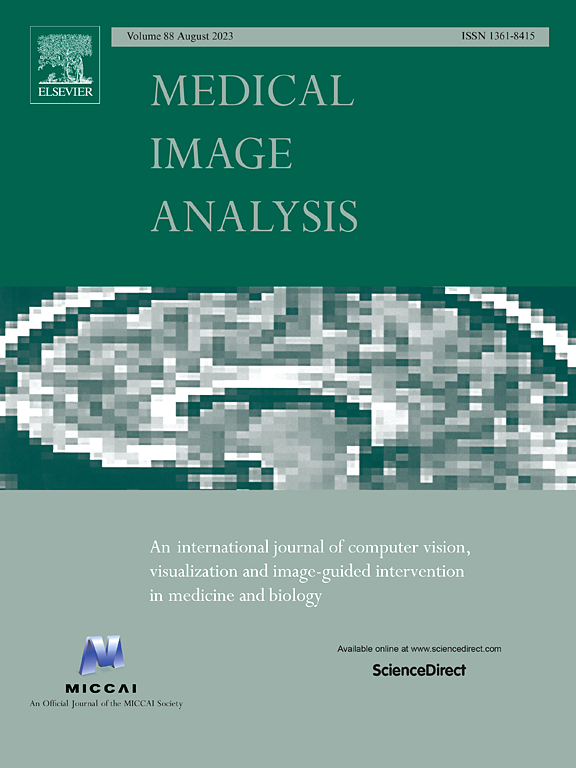Joint modeling histology and molecular markers for cancer classification
IF 10.7
1区 医学
Q1 COMPUTER SCIENCE, ARTIFICIAL INTELLIGENCE
引用次数: 0
Abstract
Cancers are characterized by remarkable heterogeneity and diverse prognosis. Accurate cancer classification is essential for patient stratification and clinical decision-making. Although digital pathology has been advancing cancer diagnosis and prognosis, the paradigm in cancer pathology has shifted from purely relying on histology features to incorporating molecular markers. There is an urgent need for digital pathology methods to meet the needs of the new paradigm. We introduce a novel digital pathology approach to jointly predict molecular markers and histology features and model their interactions for cancer classification. Firstly, to mitigate the challenge of cross-magnification information propagation, we propose a multi-scale disentangling module, enabling the extraction of multi-scale features from high-magnification (cellular-level) to low-magnification (tissue-level) whole slide images. Further, based on the multi-scale features, we propose an attention-based hierarchical multi-task multi-instance learning framework to simultaneously predict histology and molecular markers. Moreover, we propose a co-occurrence probability-based label correlation graph network to model the co-occurrence of molecular markers. Lastly, we design a cross-modal interaction module with the dynamic confidence constrain loss and a cross-modal gradient modulation strategy, to model the interactions of histology and molecular markers. Our experiments demonstrate that our method outperforms other state-of-the-art methods in classifying glioma, histology features and molecular markers. Our method promises to promote precise oncology with the potential to advance biomedical research and clinical applications. The code is available at github.

联合建模组织学和分子标记用于癌症分类
癌症具有显著的异质性和多样化的预后。准确的肿瘤分类对患者分层和临床决策至关重要。虽然数字病理学已经推动了癌症的诊断和预后,但癌症病理学的范式已经从单纯依靠组织学特征转向结合分子标记。迫切需要数字病理学方法来满足新范式的需要。我们介绍了一种新的数字病理学方法来联合预测分子标记和组织学特征,并模拟它们之间的相互作用,以进行癌症分类。首先,为了缓解交叉放大信息传播的挑战,我们提出了一个多尺度解纠缠模块,实现了从高放大倍数(细胞水平)到低放大倍数(组织水平)整张幻灯片图像的多尺度特征提取。此外,基于多尺度特征,我们提出了一个基于注意力的分层多任务多实例学习框架来同时预测组织和分子标记。此外,我们提出了一个基于共现概率的标签相关图网络来模拟分子标记的共现。最后,我们设计了一个具有动态置信约束损失和跨模态梯度调制策略的跨模态相互作用模块,以模拟组织学和分子标记的相互作用。我们的实验表明,我们的方法优于其他先进的方法在分类胶质瘤,组织学特征和分子标记。我们的方法有望促进精确肿瘤学,并有可能推进生物医学研究和临床应用。代码可在github上获得。
本文章由计算机程序翻译,如有差异,请以英文原文为准。
求助全文
约1分钟内获得全文
求助全文
来源期刊

Medical image analysis
工程技术-工程:生物医学
CiteScore
22.10
自引率
6.40%
发文量
309
审稿时长
6.6 months
期刊介绍:
Medical Image Analysis serves as a platform for sharing new research findings in the realm of medical and biological image analysis, with a focus on applications of computer vision, virtual reality, and robotics to biomedical imaging challenges. The journal prioritizes the publication of high-quality, original papers contributing to the fundamental science of processing, analyzing, and utilizing medical and biological images. It welcomes approaches utilizing biomedical image datasets across all spatial scales, from molecular/cellular imaging to tissue/organ imaging.
 求助内容:
求助内容: 应助结果提醒方式:
应助结果提醒方式:


